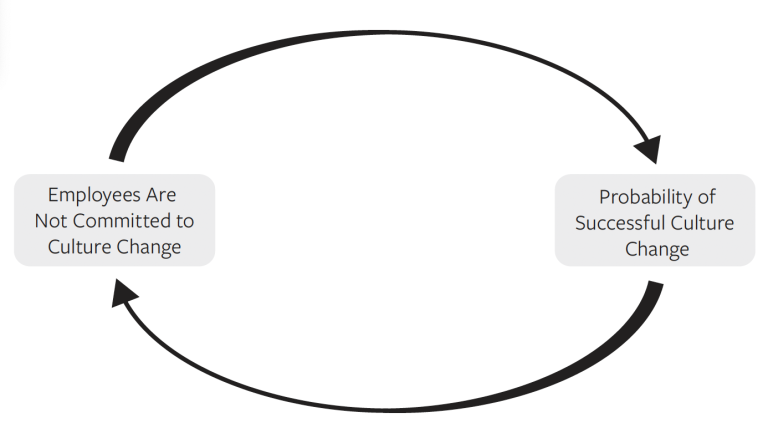What if an effort to change an organization’s culture doesn’t take?
Employees who have gone all in on a culture change can find themselves in a very uncomfortable situation—being a leading supporter of a culture change that has failed. As a result of this failure, they may be asked to leave. Or, if not asked, they may choose to leave on their own to find a place where their preferred culture already exists.
In this sense, deciding whether or not to support a culture change can often be about deciding whether or not to change jobs. Naturally, many employees—especially in the face of such high failure rates for culture-change efforts—will be cautious about making these commitments.
Ironically, this caution can be one of the reasons why a culture-change effort fails. This, then, becomes the self-fulfilling prophecy presented in the graphic above—lack of employee commitment to changing an organization’s culture can reduce the likelihood of such a change taking place, which in turn reduces the willingness of employees to commit to enabling such a change, which reduces the likely success of such a change effort, and so forth.
You can play a vital role in stopping the emergence of this “death spiral.” This happens when you credibly signal your irreversible commitment to culture change. However, simple verbal assertions that you are “really, really committed to culture change” are not enough. They are still just cheap talk.
Stopping the Death Spiral
You must put your money where your mouth is. One way to do this is to link, in a very direct (and costly to reverse) way, a story you build to support culture change with yourself as an individual. In short, you must star in your own culture-changing story. Thus, these stories:
- Can’t just be about some inspirational figure in history (“These are the leadership principles I learned from Abraham Lincoln.”)
- Can’t just be funny stories from which important management lessons can be learned (“Three CEOs walk into a bar . . .”)
- Can’t be inspirational stories about another employee in the firm (“Let me tell you about the customer service exemplified by Jane Doe in the Atlanta store.”)
- Can’t be just strongly worded statements about your commitment to culture change (“I’m really committed to culture change. Really.”)
- Can’t just be a list of your vision and values (“My core values are honesty, integrity, and commitment—just like every other business leader in the world.”)
Instead, you have to do something that builds a culture-changing story.
“Build” in the phrase “build a story” is a transitive verb. If you are not willing to do something that will build a story in your firm to help change its culture, then it is very unlikely that your employees will believe that you are truly committed to culture change. And without that commitment—death spiral.
When it comes to culture change, your deeds are more important than your words. Of course, your inspirational words can help explain and motivate the need for cultural change. But words without deeds are cheap and have limited impact. When you start “being the culture” you are trying to create, then culture change can begin.
